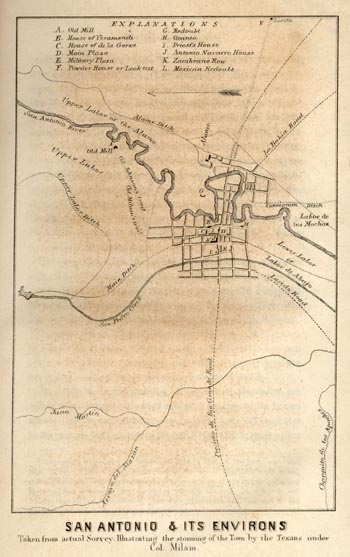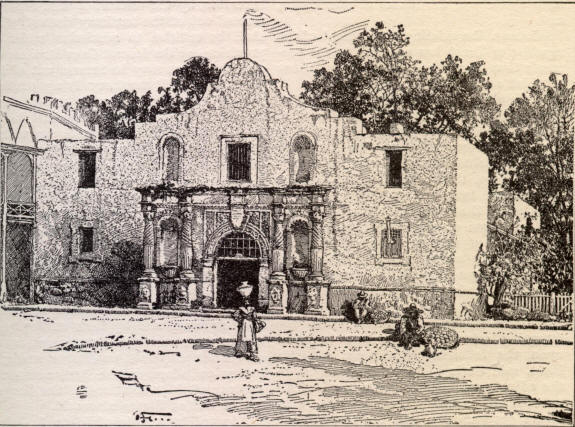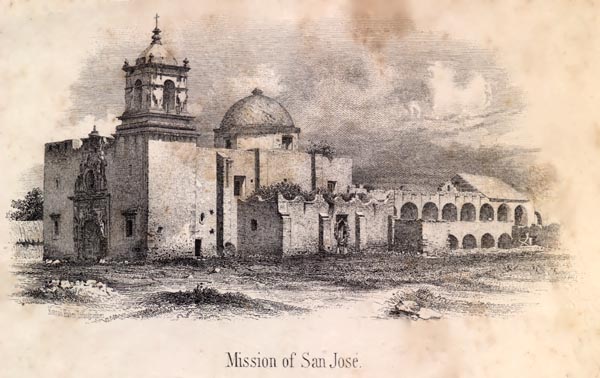Texans Capture San Antonio and the Alamo
![]()
This Site:
|
We provide this Map to help the reader follow the battle description. This Map is the one used by Colonel Milam in his Attack on San Antonio. Click on the map to be taken to an enlarged version. |
The Assault on San Antonio[Happened After: Texans Siege San Antonio] On the morning of the 3d of December, 1835, Messrs. Smith, Holmes, and Maverick, who had been detained under surveillance in Bexar since the affair at Gonzales, made their escape, and reached the Texan camp. From information given by them as to the strength of the place, a call was made for volunteers to attack it at four o'clock the next morning. The plan of assault proposed that three hundred volunteers should be led into the town in three divisions : the first, under Colonel Jack, to take and occupy the house of Jose Angel Navarro ; the second, under Lieutenant Sommervell, to take and occupy the house of Antonio de la Garza ; and the third, under Major Morris, to take and occupy the house of Veramendi. Deaf Smith, John W. Smith, and Hendrick Arnold, were to act as guides to the respective divisions. During that day and night, all was preparation and impatience for the hour to march. A serious conference was in session in General Burleson's quarters, which closed by a proclamation that the descent on the town was postponed ! |
|
The burst of disappointment and indignation which followed this announcement can be better imagined than described. A general parade was ordered for ten o'clock on the morning of the 4th. Many of the companies refused to turn out. The causes assigned for postponing the attack were, the absence of Arnold, one of the guides, together with an opinion that the besieged had received notice of the intended assault About two o'clock in the afternoon of the 4th of December, an order was issued to raise the siege, and to set out for La Bahia at seven o'clock that evening. " It was then," says an eye-witness, " that the scene was wholly indescribable, and serious apprehensions were entertained that our camp would become the theatre of blood." But, in the meantime, Arnold, the absent guide, had returned; and Lieutenant Vuavis, of the Mexican army, who had deserted the night before, came up. The latter was conducted forthwith to headquarters, and underwent a strict examination. He stated that the garrison was in a tumult, and much dissatisfied ; and, further, that the enemy had no suspicion of the intended descent that morning. He also stated that the strength of the place had been exaggerated. On receipt of this information late in the evening of the 4th, Colonel Benjamin R. Milam, at the suggestion of some persons, cried aloud, " Who will go with old Ben Milam into San Antonio?" The reply was a shout from the officers and men then assembled around the quarters of General Burleson. They were ordered to fall into line, and, after a partial organization, Milam was promptly elected to the command, and notified the men to meet him, early after dark, at the old mill—there to complete their arrangements. All this transpired in the presence of General Burleson, and with his approbation. They met at the old mill, and formed the attacking party in two divisions : the first under the immediate command of Colonel Milam, assisted by Colonel Nidland Franks of the artillery and Major R. C. Morris of the Grays, with Messrs. Maverick, Cooke, and Arnold, as guides ; the second under the command of Colonel Frank W. Johnson, assisted by Colonels James Grant and William T. Austin, with Deaf Smith and John W. Smith as guides. General Burleson was waited on, and requested to hold his position till the result of the attack on the town was known, which he cheerfully agreed to do. Colonel J. C. Neill was directed to make a feint on the Alamo, to divert the enemy's attention while Milam was marching into the place. There were three hundred and one men that made the descent, composed mostly of parts of the companies of Captains York, Patton, Dickinson, English, and Ward, in the first division, under Milam, and of the companies of Cook, Breese, Peacock, Swisher, and Edwards, in the second division, under Johnson. On the morning of the 5th of December, about twenty minutes before daylight, the assault was made on the town. Colonel Neill, making an earlier start, had crossed the river, descended toward the Alamo, and opened a fire upon it, completely diverting the enemy's attention. This he continued till he heard the report of the guns in the town, when he withdrew to the camp. The division of Milam marched in a direction a little south of west to the entrance of Acequia street (so named from the ditch running on its west side) ; while, at the same time, that of Johnson advanced to the entrance of Soledad street. These two streets from their entrance run south for a thousand varas to the main plaza—the first entering the square on the northwest and the other on the northeast corner. At these points of entrance into the square the enemy had erected breastworks and batteries, so as to command them. Milam's division took possession of the house of De la Garza, and Johnson that of Veramendi. These houses were nearly opposite, on the east side of each of the two streets, and about a hundred yards from the main square. In approaching the Veramendi house, a sentinel fired upon the column, which was returned with effect by Deaf Smith. This aroused the Mexicans in the town. The fire from the town and the Alamo soon became tremendous. The Texans had taken with them two pieces of artillery, a twelve and a six-pounder. The former was dismounted, and, for want of a cover for the other piece, it was but little used. So well directed was the enemy's fire, that, for a time, the Texans could not cover their lines, or keep up a safe communication between the two divisions. They relied, however, upon their rifles, with which they slackened the enemy's fire, and silenced the artillery within range of their pieces. During the 5th, the Texans had one killed, and two colonels, one lieutenant-colonel, and twelve privates, wounded. These were sent back to the camp. Among the wounded were Lieutenant John L. Hall, of the first Grays, and Deaf Smith. These wounds were received on top of the Veramendi house, whither some ten or fifteen had ascended to get a view of the enemy. Finding their position untenable, they descended through the roof. A writer in the 'Texas Gazette' of September 8, 1849, says Lieutenant Hall was not of the party. That officer himself states that he was.
The Alamo, San AntonioThe night of the 5th was occupied by the Texans in strengthening their works, and opening a communication between the two divisions. The enemy kept up a constant fire during the night, which slackened somewhat toward daylight. They were also engaged in placing armed men on the tops of the surrounding houses, and in strengthening their defenses. The Texans at length succeeded in opening a safe communication between their two divisions. This they did under a raking fire from the enemy's battery at the entrance of Soledad street. At daylight, on the morning of the 6th of December, the enemy were discovered to have occupied the tops of the houses between the Texans and the plaza, and to have cut loopholes in the parapet-walls crowning the buildings. From these points they opened and kept up during the day a brisk fire of small-arms ; at the same time a steady fire of artillery was maintained from the town and the Alamo. The greatest danger to the Texans was in passing from one building to another. A detachment of Captain Crane's company, under Lieutenant William McDonald, with others, advanced under a severe fire and took possession of the house to the right and somewhat in advance of the Garza house. This extended the Texan line westward, and toward the military plaza. At the same time, the assailants were strengthening their works, and returning the fire of the enemy. They also succeeded in mounting their cannon, with which they did some execution. The communication between the two divisions of the assailants was strengthened. During this, the second day of the attack, the Texans had five wounded. The night of the 6th was occupied by the enemy in keeping up a languishing fire, in opening a trench on the Alamo side of the river, and in strengthening their batteries on Main street, leading from the plaza to the Alamo. The Texans were engaged in strengthening their lines. On the morning of the 7th, the enemy opened a brisk fire from the trench constructed the night before; also of artillery and small-arms from other positions. By eleven o'clock that day, the deadly fire of the Texan rifles had silenced that from the trench, and also from some of the Mexican artillery. The only house between the Garza house and the buildings on the plaza was about midway, but back from the street. About noon, the gallant Karnes advanced with a crowbar, under a heavy fire from the enemy, and forced an entrance. Captain York's company followed, and held the position. In the evening the fire of the Mexicans became active from all their works. Colonel Milam, in passing from his position to that of Johnson at the Veramendi house, was instantly killed by a rifle-shot in the head. He fell just as he entered the yard. In his death, Texas lost a commander and a soldier whose place could not be easily supplied (Milan was buried on the spot where he fell). The Texans, however, felt a new incentive to avenge his death. They immediately set on foot a party to take possession of the house of Antonio Navarro, situated on the north side of Main street, one block west of the main plaza, but commanding a portion of the military plaza, and the Mexican redoubt on the second block west of the main square. The party consisted of portions of the companies of Captains Llewyllen, English, Crane, and York. They advanced from the house taken by Karnes, and forced an entrance. The enemy endeavored to retake it by firing through loopholes made in the roof ; but the Texans returned the fire through the same loopholes, and drove them off. Immediately north of and adjoining the Navarro house, fronting on Flores street, stood a row of buildings known as the " Zambrano Row." The taking of these buildings was part of the work of the 8th of December. The morning was cold and wet, and but little was done. About nine o'clock, however, the same party who had taken the Navarro house, being reinforced by the Grays, commenced the attack. The row consisted of a series of rooms, separated by thick partition walls. These walls were pierced, and thus the Texans advanced from room to room. The enemy disputed every inch of the ground, and kept up a tremendous fire of artillery during the day. At last, however, they were forced to abandon the row. During this time, a small reinforcement, under Lieutenant Gill, came in from the camp of General Burleson. The Mexicans, in order to produce a diversion, sent out a party of about fifty men from the Alamo toward the Texan camp, but they were quickly driven back by the fire of a six-pounder. After dark, on the 8th, the occupants of the Zambrano row were reinforced by the companies of Captains Swisher, Alley, Edwards, and Duncan. Thus the Texans had, in fact, the command of the north-west portion of the enemy's main defenses. On the night of the 8th, a further advance was made. On the north side, and opposite the centre of the main plaza, stood a strong building known as the " Priest's House." It commanded the plaza, and its capture was considered the crowning work of the assault. Just before midnight, a party of about a hundred men, destined to attack this place, set out from the Garza house. In passing an outbuilding connected with the wall around the yard of the priest's house, they were exposed to a heavy fire from the Mexicans occupying that outbuilding; but by a rapid movement the assailants reached the wall, broke it down, drove the enemy from his position, entered the priest's house, secured and strengthened the doors and windows, and commenced cutting loopholes. The fire of the enemy had by this time become general, and was kept up with artillery and small-arms until nearly daylight. Finding the Texans unpleasantly near them, they did not wait for daybreak to see the effect of their rifles from the loopholes in the priest's house upon the main plaza, but retreated to the Alamo. At half past six o'clock, on the morning of the 9th, General Cos sent in a flag of truce, expressing a wish to capitulate. General Burleson, having received notice of the flag, proceeded to the town ; and by two o'clock, on the morning of the 10th, the articles of capitulation were concluded. Cos and his officers were permitted to retire with their arms and private property, upon their word of honor that they would not in any way oppose the re-establishment of the constitution of 1824 ; the Mexican convict-soldiers were to be taken beyond the Rio Grande ; all public property belonged to the victors; such of the troops as wished to remain, or leave the Mexican army, had the liberty of doing so. Commissioners were appointed to carry the articles into effect. It is proper here to state that during the attack, notwithstanding General Burleson had out a constant patrol, Ugartachea made his way into San Antonio with five hundred convicts, guarded by a hundred regular infantry. This force, added to the eight hundred previously there, made an aggregate of fourteen hundred. The number of the enemy killed has been variously estimated : it probably did not exceed a hundred and fifty. The Texan loss was trifling, though they had several wounded. Among the occurrences of the assault, it may be stated that on the same evening of the death of Milam, the officers assembled and conferred the command on Colonel Frank W. Johnson, who had the high honor of raising the flag of victory over the walls of Bexar. The reinforcement of convicts brought in by Ugartachea were conducted in chains, and their fetters were only taken off when they were introduced within the lines. Such men added nothing to the Mexican strength, but served only to hasten the consumption of the scanty provisions of the besieged. After the occupation of the priest's house by the Texans, the town was fairly in their possession. They were in a position, as soon as daylight appeared, to clear every battery on the plaza. The terms of the capitulation were, then, humane. It is true the enemy could have held out for some time in the Alamo, but they had no provisions. The Texans agreed to furnish them with a supply at a fair price, and their sick and wounded were permitted to remain behind, and were duly cared for. Thus the humanity following the victory was more glorious than the victory itself, and was a noble lesson of moderation in the hour of triumph, which the enemy failed to learn. Twenty-one pieces of artillery, five hundred muskets, together with ammunition, clothing, etc., fell into the hands of the victors.
On the 14th, General Cos left the town with eleven hundred and five troops, the remainder having abandoned his flag. He encamped that night at the mission of San Jose. The next day he set out for the Rio Grande, to report to Santa Anna, his distinguished relative and superior, the rebellious character of the Texans, and their obstinacy in battle. General Burleson, who, although opposed to the attack, when it was begun did all he could to contribute to its success, on the 15th retired to his home, leaving Colonel Johnson in command at the Alamo, with a sufficient force to maintain it. The remainder of the army dispersed. Thus was Texas again free from the footsteps of the enemy. [See Next: Raising War Revenue] * The account of the storming of San Antonio is taken from the official reports of General Burleson, of the 14th of December, 1835; of Colonel Francis W. Johnson, of the same date; from the "Emigrant's Guide" of January 16, 1836; the "State Gazette" of September 1, 8, and 15, 1849; and from the statements of several of those engaged in the contest. |
|
![]()
|
Site Copyright © 2003-2018 Son of the South. For questions or comments, contact paul@sonofthesouth.net. |
|
|
|
Are you Scared and Confused? Click Here to read My Snake Story, a story of hope and encouragement, to help you face your fears. |
||


